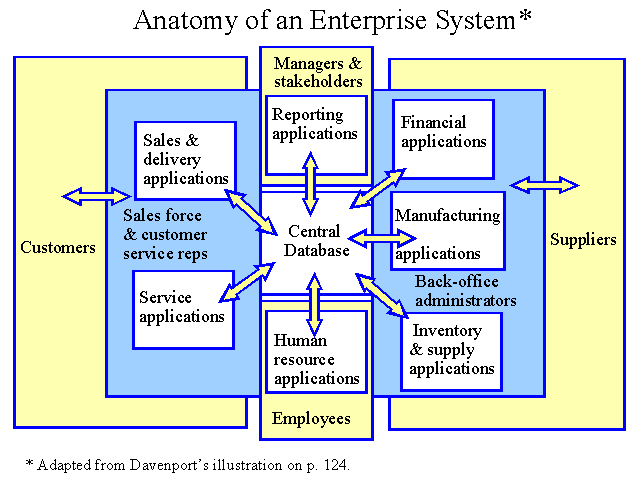
Summary by Chi Doan
Master of Accountancy Program
University of South Florida, Summer 2003
AIS/MIS Main Page | ERP/EPM
Main Page | Electronic Commerce Main Page
Implementing enterprise systems is not always a simple and straightforward process that automatically increases efficiency. In fact, companies encounter various problems when attempting to install enterprise systems that can turn into a nightmare.
Some of the blame for failures of enterprise systems lies with the technical challenges of implementation. These systems are costly and complex, requiring large investments of money, time, and expertise for installation. However, the main reason enterprise systems fail is business related: companies fail to reconcile the technological imperatives of the enterprise systems with the business needs of the enterprise itself.
At the core of an enterprise system is a single comprehensive database. When new information is entered in one place, related information is automatically updated. Despite its capacity to integrate, an enterprise system is not flexible. It is a generic solution that does not always fit with each enterprise’s individual characteristics. See the illustration below for a graphic view of an enterprise system.

An enterprise system, by its nature, imposes its own logic on a company’s strategy, organization, and culture. It pushes a company toward full integration even when a certain degree of business unit segregation may be in its best interests.
Some degree of enterprise system customization is possible. For example, because the systems are modular, companies can install only those modules that are most appropriate to their business. However, the system’s complexity makes major modifications impracticable. As a result, most companies installing enterprise systems will need to adapt or even completely rework their processes to fit the requirements of the system.
Because an enterprise system is a generic solution, problems arise when the company’s competitive advantage derives primarily from the distinctiveness of its products. For companies that compete on cost rather than on distinctive products or superior customer service, the cost of an enterprise system is often too great and it is more cost effective not to implement the system.
In addition to strategic implications, enterprise systems also have a direct and paradoxical impact on a company’s organization and culture. By providing universal, real-time access to operating and financial data, they allow companies to streamline their management structures and create flatter, more democratic organizations. On the other hand, they also involve centralization of control over information and standardization of processes, which are qualities more consistent with hierarchical organizations with uniform cultures. To preserve local autonomy, some companies such as Hewlett-Packard, Monsanto, and Nestle use a "federalist model" (i.e., power to the states) where the ERP system is tailored to support local operating practices.
A number of questions should be answered before any decisions are made to adopt an enterprise system. For example:
How might an ES strengthen the company’s competitive advantages?
How might it erode them?
What
will be the system’s effect on the organization’s culture?
Does the company need to extend the system across all functions, or
implement only certain modules?
Would
it be better to roll the system out globally, or restrict it to certain regional
units?
Are there other alternatives
for information management that might actually suit the company better than an ES?
Finally, since the enterprise system has profound business implications, top management should be involved in the decision making process. The risk of off-loading the implementation of the ES to technologists is to dangerous. Management must either control the development and implementation of the enterprise system to insure that the system fits the company, or risk becoming under the control of a generic system that forces the company to change to fit the ES.
___________________________________________
Related summaries:
Appelbaum, D., A. Kogan and M. A. Vasarhelyi. 2017. An introduction to data analysis for auditors and accountants. The CPA Journal (February): 32-37. (Summary).
Appelbaum, D., A. Kogan, M. Vasarhelyi and Z. Yan. 2017. Impact of business analytics and enterprise systems on managerial accounting. International Journal of Accounting Information Systems (25): 29-44. (Summary).
Bensaou, M. and M. Earl. 1998. The right mind-set for managing information technology. Harvard Business Review (September-October): 119-128. (Summary).
Campbell, A. 1999. Tailored, not benchmarked: A fresh look at corporate planning. Harvard Business Review (March-April): 41-44, 46,48, 50. (Summary).
Elliott, R. K. 1992. The third wave breaks on the shores of accounting. Accounting Horizons 6 (June): 61-85. (Summary).
Martin, J. R. Not dated. What is data mining? Management And Accounting Web. DataMining.htm
Martinsons, M., R. Davison and D. Tse. 1999. The balanced scorecard: A foundation for the strategic management of information systems. Decision Support Systems (25): 71-88. (Summary).
Roberts-Witt, S. L. 2002. Data mining: What lies beneath? Finding patterns in customer behavior can deliver profitable insights into your business. PC Magazine (November, 19): iBiz 1-6. (Note).
Tschakert, N., J. Kokina, S. Kozlowski and M. Vasarhelyi. 2017. How business schools can integrate data analytics into the accounting curriculum. The CPA Journal (September): 10-12. (Summary).
Williams, S. 2011. 5 Barriers to BI success and how to overcome them. Strategic Finance (July): 26-33. (Note).